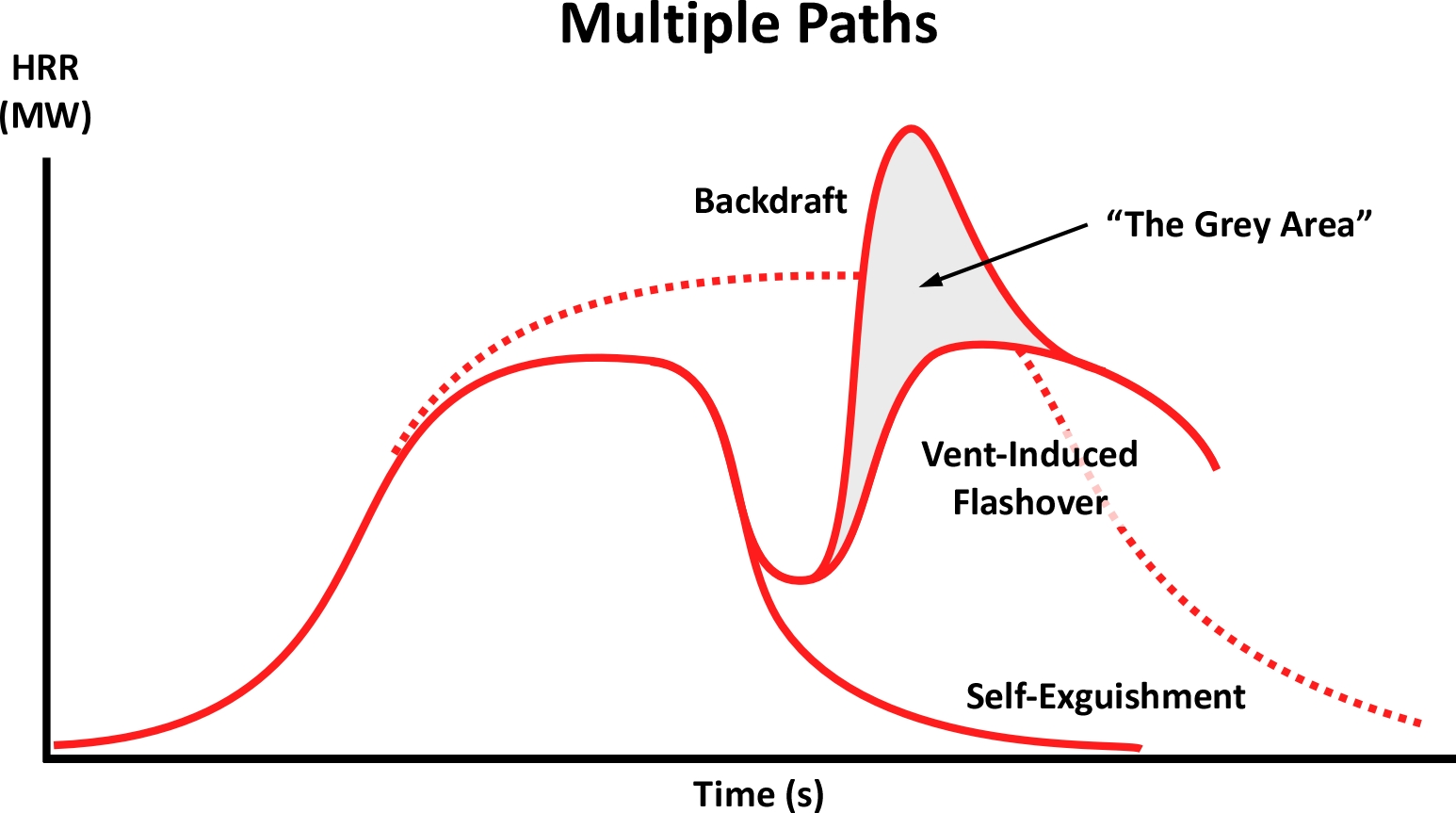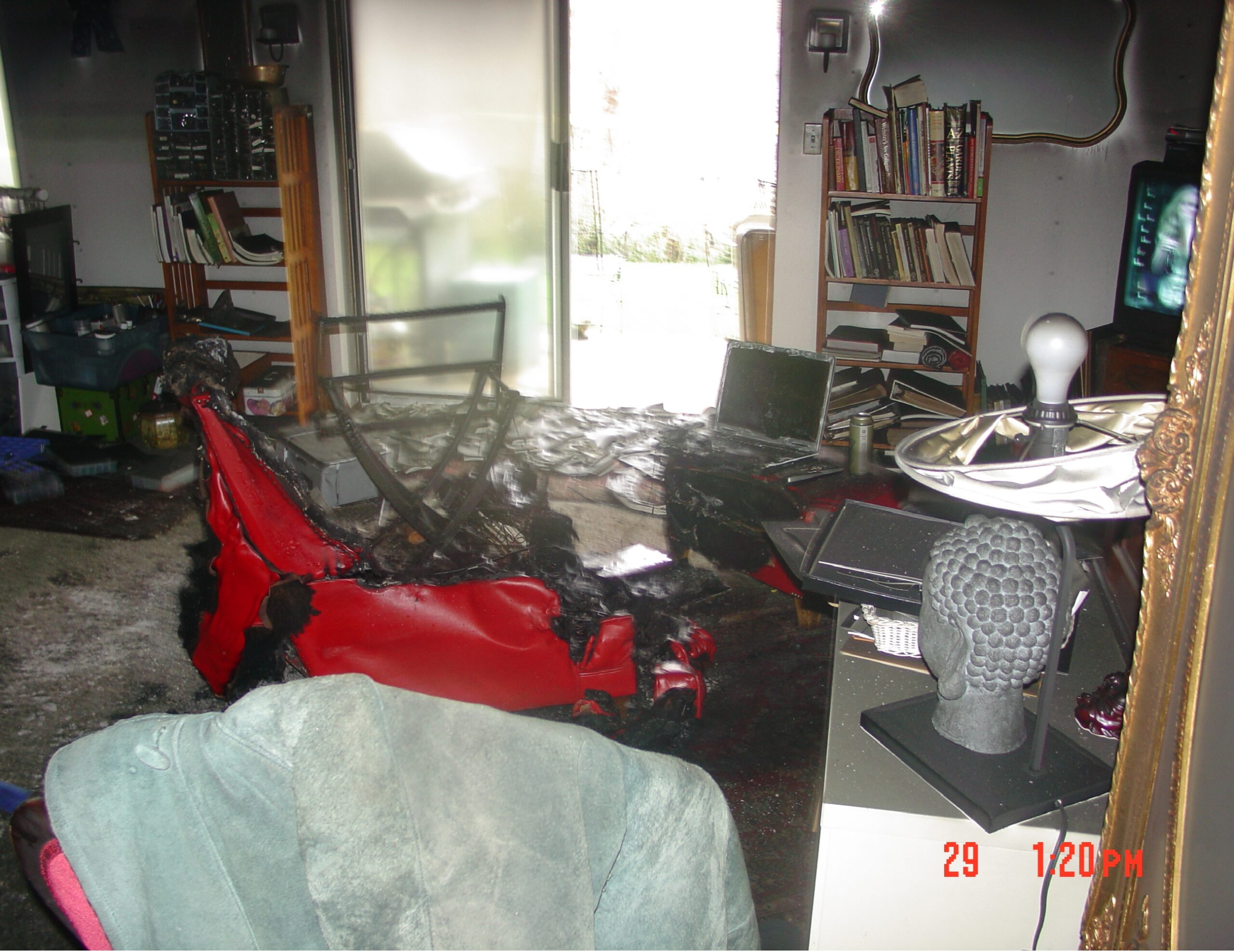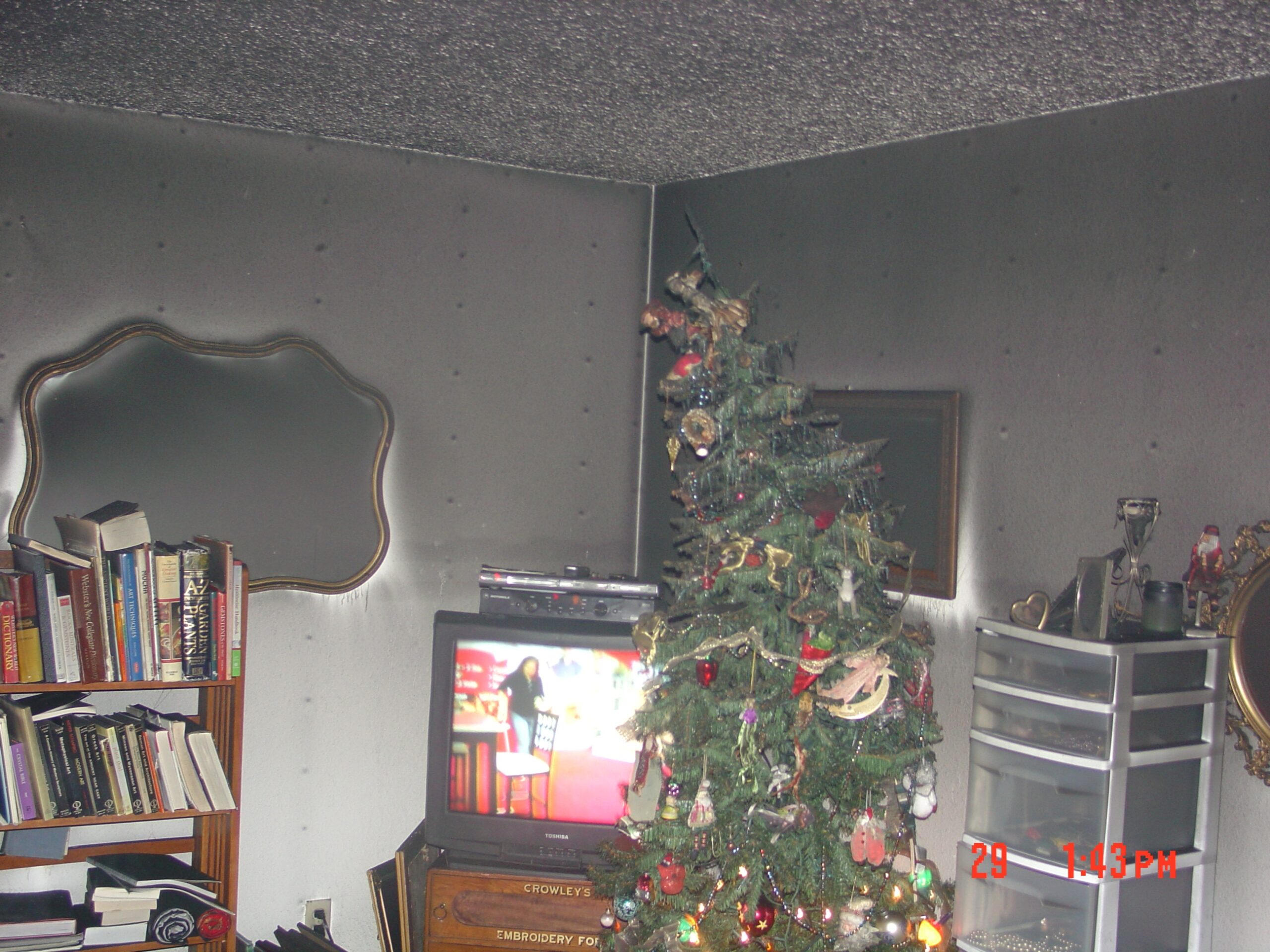Ventilation and Ventilation-limited Fires
As discussed in the last post (Backdraft and Smoke Explosion: Part 3), with normal ventilation fires in buildings other than large open plan structures will generally become ventilation limited early in their development. In typical residential occupancies and smaller commercial occupancies, fires that have progressed significantly into the growth stage likely be ventilation limited. Here are a few things to keep in mind:
- If ventilation is increased to a ventilation limited fire (without application of water for fire control), heat release rate will increase.
- If there is an open window or door with smoke exhaust and air intake, this does not mean that the fire is fuel limited (it is likely still ventilation limited).
- If there are flames from one or more windows or doorways, this does not mean that the fire is fuel limited. Fully developed fires in an intact enclosure are generally fuel limited.
- Conditions can vary considerably at different locations inside the fire building. The oxygen and gas phase fuel concentrations are not uniform and can vary considerably from compartment to compartment and at different levels within compartments. Individual fire compartments or areas can also vary in stages of fire development (growth, fully developed, or decay).
- Changes in ventilation may be unplanned (e.g., failure of a window or creation of an opening outside the incident action plan) or planned (e.g., tactical ventilation).
Multiple Paths and the “Grey Area”
There are many variables that influence the behavior of a ventilation limited fire when ventilation is increased. Let’s leave effective application of water for fire control prior to ventilation off the table for now (as this likely would return the fire to a fuel limited state).
There are three general paths that a ventilation limited fire may take when ventilation is increased.
- The fire may not return to the growth stage, but may simply continue heterogeneous combustion (smoldering).
- The fire may return to the growth stage and progress through flashover to a fully developed stage. This is a ventilation induced flashover.
- The fire may undergrow explosive regrowth resulting in overpressure. This is a backdraft.
- The “grey area” is where a fire rapidly increases in heat release rate, where there is not a clear difference between ventilation induced flashover and backdraft (Bengtsson, 2001). Sometimes it is difficult to differentiate between these fire behavior phenomena (or between backdraft and smoke explosion) when they occur during firefighting operations.

Self-Extinguishment
If the oxygen concentration is reduced to the point where flaming combustion can no longer continue, heterogenous (surface) combustion may continue in porous fuels, this will provide sufficient heat release rate for temperatures to remain sufficiently high to continue pyrolysis, increasing the concentration of gas phase fuel in the smoke. However, like homogenous (flaming) combustion, heterogeneous (surface) combustion requires oxygen to release thermal energy, further depleting the oxygen concentration within the enclosure and bringing the fire deeper into decay., Eventually, the heat release rate will reduce sufficiently for the fire to self-extinguish and temperatures will return to ambient (but this will likely take a substantial amount of time).
If ventilation is increased while heterogeneous combustion is continuing at an extremely slow rate, the fire may be fuel limited (as there is now ample oxygen concentration, but insufficient heat for the fire to quickly return to the growth stage.
An incident occurring in Gresham, Oregon on December 29, 2007 provides an excellent example of this path. An engine and truck company were dispatched to an odor of smoke at a garden style apartment complex. The reporting party indicated that they had smelled smoke late the previous night and it persisted until morning when they called 911. Investigating, the officer on the truck company observed darkened windows in a first-floor apartment and fingers of soot around the exterior door.

Note: Gresham Fire & Emergency Service photo.
He called for a first alarm assignment for a structure fire and the engine company stretched an attack line. They forced entry and discovered that the fire, which had originated in a living room chair, had substantially self-extinguished.

Note: Gresham Fire & Emergency Service photo.
While other fuel packages in the apartment, particularly those at upper levels showed evidence of thermal impact (e.g., melting and charring), the rapid depletion of oxygen within the enclosure limited fire development. The time lapse between the fire entering decay and the change in ventilation provided by the fire companies forcing entry through the front door allowed temperatures within the apartment to drop to near normal (first arriving personnel described the temperature in the apartment as “warm”).

Note: Gresham Fire & Emergency Service photo.
Ventilation Induced Flashover
If ventilation is increased to a ventilation limited fire that is still in the growth stage or shortly after the fire has entered the decay stage where temperatures are still high, the heat release rate may increase sufficiently for the fire to transition through flashover to a fully developed stage. The following video from firegroundimages.com provides an excellent illustration of ventilation induced flashover.
Note: Muratori, K. (2020). Turbulent smoke transitioning to flashover. https://bit.ly/4muWr3w.
While ventilation induced flashover and backdraft are both caused by an increase in ventilation, the transition to flashover is not a deflagration resulting in a potentially damaging pressure increase (more on deflagration and explosions in the discussion of backdraft).
Backdraft
The definition of backdraft provided in NFPA 921 and NFPA 1700; “a deflagration resulting from the sudden introduction of air into a confined space containing oxygen-deficient products of incomplete combustion” (NFPA, 2024, 3.3.19 & NFPA, 2022, 3.3.6). Let’s unpack this definition.
An explosion is a sudden, rapid release of energy that produces potentially damaging pressures (O’Connor, 2023).
When a gaseous fuel fills a space, it needs to mix to a certain air-fuel concentration to create an explosive atmosphere. When an ignition source is introduced into the explosive atmosphere, it creates a flame that travels away from the ignition site and expands the burned gases behind the flame front. When an explosion is confined, it creates a restraint of the expanding gases and results in an increased pressure within the enclosure. The damage potential of an explosion depends on the pressure that is created from the explosion as well as how quickly energy is released from the explosion (O’Connor, 2023).
A deflagration is an explosion where the flame speed is lower than the speed of sound, which is approximately equal to 335 m/sec (750 mph) (O’Connor, 2023).
This provides a bit more clarity. Damage resulting from overpressure can be seen after the fact, but it is impossible to determine flame speed when observing a rapid fire progression event on the fireground.
Backdraft Scenario
Consider a fire burning inside a building with all the windows and doors closed. Normal leakage through small cracks around windows and doors provides limited ventilation. Fire consumes oxygen as it releases energy and raises the temperature and pressure within the building. Increasing pressure pushes smoke out around the windows and doors. Hot unburned fuel and other products of combustion rise until it reaches the ceiling and then spread horizontally through the building, forming a thick layer of smoke. As the fire continues to burn, the concentration of oxygen becomes lower, reaching a point where it will not support flaming combustion. With low oxygen concentrations, the fire continues to smolder.
Failure of a window or opening a door increases ventilation. As hot smoke is less dense, it rises and flows out the top of the opening while cooler air which is more dense flows in the bottom of the opening, creating a gravity current. The flow of hot smoke and air creates turbulence, mixing the smoke and air where the two layers meet. This mixing extends from the ventilation opening into the compartment.
The air entering the compartment increases the oxygen available for combustion at the lower level, returning smoldering to flaming combustion, igniting the mixing unburned products of combustion and air. As the fuel and air burn, temperature and pressure increase, creating turbulence and forcing unburned products of combustion out the opening. Increasing temperature explosively pushes the burning mixture of fuel and air out of the opening, creating a fireball. Accumulation of unburned products of pyrolysis and combustion, mixing of unburned gaseous fuel, the ignition and propagation turbulent explosion, is a backdraft (Fleischmann, Pagini, & Williamson, 1994 & Fleischmann & Chen, 2013).
Demonstrations of the backdraft phenomena are often conduced using a “window cell” constructed from a 6.1 m (20’) steel shipping container. In these demonstrations a large fuel load is placed inside the container and allowed to progress through the growth stage to a fully developed fire with the door and windows (if equipped with windows) open. Once the fire is sufficiently developed, the openings are closed and the fire allowed to go into the decay stage as oxygen within the cell is consumed. Then a door or window (top of a split or Dutch door) as illustrated below is opened allowing air to enter. If the concentration of gas phase fuel is sufficient and return of heterogenous (surface) combustion to homogenous (flaming) combustion ignites the products of combustion and pyrolysis products and atmospheric oxygen, a backdraft occurs.

In this type of demonstration, it is critical for the instructor to set the context as there are several differences between this type of demonstration and backdrafts occuring in the built environment during firefighting operations.
- Construction and Configuration: The window cell is a single compartment and has different type of construction than most buildings. While a backdraft may occur in a single compartment, most buildings are comprised of multiple compartments and structural void spaces. Conditions conducive to occurrence of a backdraft may develop remote from the ventilation opening, influencing the potential for occurrence and/or delay between increased ventilation and occurrence of a backdraft. In many types of buildings, compartment linings serve as an insulator rather than a thermal reservoir (e.g., gypsum board versus steel), this too may influence backdraft potential (Gottuk, Williams, and Farley, 1997).
- Fuel Load: The fuel load is different. The fuel used in the window cell is often (but not always) particleboard or chipboard manufactured from wood chips and a synthetic, mostly formaldehyde-based resin or other suitable binder. While this type of fuel may be found in buildings (often as part of furniture), normal fuel loads in buildings includes a wide variety of contents and often includes combustible structural materials. The fuel load in the window cell is selected to provide predictability and repeatability of backdraft demonstrations.
- Ventilation Profile: The fire is initially well ventilated (door and windows open) and allowed to progress from the growth stage through flashover to a fully developed state prior to the ventilation openings being closed. For fires occurring in the field, ventilation is generally limited from the start of the fire until either fire effects or firefighters change the ventilation profile. Under this type of ventilation profile, creation of backdraft conditions may take considerably longer.
While for an experienced instructor, the window cell provides the capability to repeatedly and consistently demonstrate many characteristics of the backdraft, backdraft potential in the built environment is considerably more variable. The following video provides an example of a backdraft demonstration using a window cell.
Note: CFBT-International (2005). Training backdraft
While the time between increased ventilation and a backdraft is considerably variable, the deflagration of products of combustion and pyrolysis and atmospheric oxygen is quite fast. Use of high-speed video allows this phenomena to be examined in a bit more detail. If you set aside the narration, the following video provides an interesting look at a backdraft demonstration using a window cell.
Note: The Slo Mo Guys. (2019). 4K Slow Motion Backdraft. https://bit.ly/4ktgCwK.
There are many videos available on line purporting to show backdrafts during actual incident operations. It is likely that some of them do, but many others may show some other types of phenomenon (e.g., smoke explosion, interior collapse pushing smoke and flames out of openings, compressed gas cylinder explosions inside the building, etc,.) it is often difficult to determine based on video taken from a single perspective.
The following video shows an explosion during firefighting operations at a restaurant. This incident occurred at PH Bistro, a restaurant located on South Main Street in Franklin, Ohio, on October 3, 2011 shortly after 07:30. Responding companies arrived to find heavy black smoke coming from the building. As crews entered the building, an explosion occurred, causing the front windows of the restaurant to fail (CNN, 2011).
Note: Cable News Network (CNN). (2011). Backdraft explosion caught on camera. https://bit.ly/436ojDm
On January 28, 2000 a fire destroyed the mixed use residential over commercial Daniels Block on Railroad Street in Saint Johnsbury, VT, near the intersection of US Route 4 and Vermont Route 2. The fire originated in a basement furnace room and first alarm companies arrived to find occupants trapped on the second and third floor. First floor windows on Floor 1, Side Alpha partially failed during firefighting and resuce operations and the IC reported that smoke issuing from these windows was moving with low velocity and little turbulence. Conditions quickly worsened on the upper floors with companies reporting tha turbulent smoke was pushing from openings in the floors and walls. Following a strategic shift and initiation of defensive fire control from Side Alpha, an explosion occurred. Video of this incident is from a law enforcement dash camera (note that the date on the video is incorrect) (Clemente, 2006; Smith, 2018, Occaso, 2018).
Note: Clemente, E. (2006). Daniel’s Block fire-backdraft . https://bit.ly/4mjEgxn
As previously noted, it is difficult to definitively determine if an explosive event occurring during firefighting operations was a backdraft simply from a video taken from a single perspective. Give some thought to these two incidents and if you think the phenomena were backdrafts? Why or why not?
The next post in this series will examine the requisite preconditions for a backdraft to occur and indicators of potential backdraft conditions. Then we will move on to a deep dig into smoke explosions. Based on some recent information I have uncovered, I will likely go back to Backdraft and Smoke Explosion: Part 3 and rework the section on flammability of smoke (in digging into the backdraft scientific literature I found several better illustrations to explain these concepts).
References
Cable News Network (CNN). (2011). Backdraft explosion caught on camera. Retrieved May 20, 2025, from https://bit.ly/436ojDm.
CFBT-International (2005). Training backdraft. Retrieved May 21, 2025, from https://bit.ly/44O8KBA
Clemente, E. (2006). Daniel’s Block fire-backdraft . Retrieved May 20, 2025, from https://bit.ly/4mjEgxn.
Fleischmann, C. & Chen, Z. (2013). Defining the difference etween backdraft and smoke explosions. Procedia Engineering, 62, 324 – 330.
Fleischmann, C.; Pagni, P.; & Williamson, R. (1994). Quantitative backdraft experiments. Fire Safety Science, 4, 337-338. Doi: 10.3801/IAFSS.FSS.4-337.
Gottuk, D.; Williams, F.; & Farley, J. (1997). The development and mitigation of backdrafts: a full-scale experimental study. Fire Safety Science, 5, 935-936. doi: 10.3801/IAFSS.FSS.5-935.
Muratori, K. (2020). Turbulent smoke transitioning to flashover. Retrieved May 20, 2025, from https://bit.ly/4muWr3w.
National Fire Protection Association (NFPA). (2022). NFPA 1700 Guide for Structural Fire Fighting. Quincy, MA: Author.
National Fire Protection Association (NFPA). (2024). NFPA 921 Guide for Fire and Explosion Investigations. Quincy, MA: Author.
Occaso, C. (2018). New bookstore opens in St. Johnsbury. Retrieved May 20, 2025, from https://bit.ly/3Zt7sZ1.
O’Connor, B. (2023). Explosions, deflagrations, and detonations. Retrieved April 11, 2025, from https://bit.ly/4icnJbl.
Smith, D. (2018). St. Johnsbury killer fire may have started in basement. Retrieved May 20, 2025, from https://bit.ly/437sC1d.
The Slo Mo Guys. (2019). 4K Slow Motion Backdraft. Retrieved May 21, 2025, from https://bit.ly/4ktgCwK.